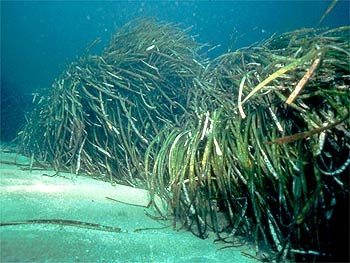|
Poseidonia
(Poseidonia oceanica)

Characteristics
It is a submerged
marine plant (not an alga), which forms vast underwater thick
meadows from 1 to 40 m depth.
This plant has a subterranean rhizome from which green leaves, reaching 1m
in lengh, grow slowly.
The Poseidonia has green flowers and fruits who look like green olives.
Ecological
importance
The Poseidonia
meadows are the largest marine producers of oxygen and biomass
and one of the most diverse marine communities, with more than
1000 associated species of algae, invertebrates and fishes.
Besides, they control the flow of the sediments by their roots
and decrease the strength of the waves by their leaves.
In this way they protect non only of marine biodiversity, but also the shores
against erosion.
Poseidonia is very demanding in light. It can live only where the luminosity
is strong, and therefore where the transparency of waters is good. Where the
euthrophication is high, the water turbidity increases, the light penetration
at depth reduces and the Poseidonia beds are endangered.
|
|
Influence
of man
The anthropic
aggressions have as result a large regression of Poseidonia
sea-grass meadows.
In addition to other threats, Poseidonia beds are being invaded by a fast growing
tropical green alga, which was accidentally introduced to the northern Mediterranean
in 1984.
Poseidonia oceanica can be listed as the main Mediterranean bioindicator of
non polluted areas and the regression of areas occupied by Poseidonia can be
considered as an ecological disaster.
Poseidonia oceanica is protected under the EU habitats directive. |

